 |
|||||
| ||||||||||||
Effect of Synthetic Amino Acid Supplementation and Diet Formulation Procedures on Nutrient Excretion and Odor and Gas Emissions in Grow/Finish Pigs
This research is funded in part with Minnesota Pork Producer checkoff dollars.
| Study by
researchers G. C. Shurson J. S. Knott College of Veterinary Medicine University of Minnesota |
Introduction
Legislative policy and public pressures are causing pork producers to implement new technologies that reduce gas and odor emissions and manage manure nutrients to prevent water pollution from swine production facilities. Therefore, there is an eminent need to examine different methods of reducing nutrient and gas output associated with pork production. In the past, methods attempting to reduce or control odors include masking, adding chemicals, changing the physical properties of livestock manure through mechanical means or by modifying manure storage structures, e.g. biofilters, covers. Although some of these methods have been effective in reducing odors and gas emissions, new technologies are needed to further reduce odor emissions and nutrient excretion, while minimizing associated production costs. Dietary manipulation is a potential approach that promises to be a partial solution for addressing the public and producer concern over livestock odor and manure nutrient management.
Most studies involving dietary manipulation have evaluated the addition of ingredients or substances to diets to alter microbiological and or digestive processes in the gastrointestinal tract. However, dietary manipulation can also involve managing digestible nutrient intake of the pig, which can result in less excretion of nutrients in manure and lower gas and odor emissions. By increasing the amount of synthetic amino acids such as lysine, methionine, tryptophan and threonine in the diet, less soybean meal is needed to meet the amino acid requirements of growing pigs, thereby reducing the amount of excess nitrogen in the diet. As a result less nitrogen would be excreted in the urine and feces, which can lead to a potential reduction in ammonia emissions from manure storage facilities.
Diet manipulation has been an effective, successful way of reducing gas and odor emissions. Hobbs et al. (1995) added synthetic amino acids to the diets of growing-finishing pigs to reduce the crude protein content of the diet. As a result, urinary nitrogen excretion was reduced, causing a reduction in ammonia emissions. Selecting feedstuffs and formulating diets that are low in excess sulfur and nitrogen, can reduce sulfur and nitrogen excretion, resulting in reduced hydrogen sulfide and ammonia emissions (Whitney et al., 1998; Sutton et al., 1999).
Some feed ingredients have fiber characteristics that may be effective in shifting nitrogen excretion away from urine and toward feces. If more nitrogen is excreted in the feces, it is in a chemical form more resistant to volatilization.
Dietary inclusion of oligosaccharides in the diet has been shown to shift nitrogen excretion away from urinary excretion and toward fecal excretion, resulting in reduced ammonia emissions. Dietary inclusion of tea polyphenols has been shown to reduce the production of ammonia (Terada et al., 1993). The inclusion of Jerusalem artichoke, which is a source of inulin, may affect the proliferation of Bifidobacteria and reduce swine manure odors (Farnworth et al., 1995). Yucca shidigra extract has been shown to inhibit urease activity, causing a reduction in the formation of ammonia, resulting in decreased ammonia emissions (Ellenberger et al., 1985; Gibson et al., 1995; Goodall et al., 1988). Additionally, feed additives including different bacterial strains, such as Bacillus subtilus, have been evaluated and may have some application in reducing hydrogen sulfide emissions (Knott et al. 2000).
Another potential method to manage the odor created by pigs is by utilizing different formulation procedures. Currently, swine diets are formulated on a total or apparent digestible amino acid basis. These formulation techniques fail to account for endogenous amino acid losses from protein turnover in the gastrointestinal tract and endogenous secretions and are imprecise in maximizing nitrogen and sulfur utilization. Amino acids from protein turnover and endogenous secretions can be absorbed and provide for the pig's daily amino acid requirements. Therefore, by formulating on a total amino acid basis, diets contain excess nitrogen (amino acids), which is ultimately excreted by the pig. Standardized ileal digestibility (SID) formulation is a relatively new method that can be used to minimize excess amino acids in the diet. This method takes into account endogenous losses caused by specific feed ingredients and uses these values to determine amino acid values for that particular feedstuff (Rademacher, M., W. C. Sauer, A. J. M. Jansman, 2000). Therefore, less amino acids are needed in the diet to achieve the pig's amino acid requirements. Additionally, formulating diets that optimize the ideal protein ratio will reduce excess amino acids in the diet. This has the potential to reduce nitrogen and sulfur concentrations in the slurry and may potentially reduce gas emissions such as ammonia and hydrogen sulfide.
The objectives of this study were to evaluate the effectiveness of using SID to formulate practical swine diets, which requires the addition of a precise balance of synthetic amino acids, on reducing odor, ammonia, and hydrogen sulfide emissions and on nitrogen, energy, and sulfur retention and excretion for grow-finish pigs. Additionally, we also evaluated the pH and temperature of anaerobic manure pits to try to quantify the effects of formulation procedure and supplemental synthetic amino acids on manure characteristics.
Materials and MethodsA total of 18 barrows with an average initial weight of 18.2 kg were used in a 16-week study at the University of Minnesota's research facility located in Rosemount, Minnesota. A total of eight pigs were assigned to each of two dietary treatments and pigs remained on their respective treatment group for the entire 16-week trial. An additional pig was allotted to each the control and experimental treatment groups in the event that a pig would need to be removed from the study due to health reasons. Four pigs from each treatment were housed in individual metabolism crates for alternating two-week periods. The remaining pigs from each treatment were housed in-groups and allowed ad libitum access to their respective experimental diets. At the end of each two-week period, pigs in metabolism crates were switched with treatment mates originally in-group pens, and were allowed ad libitum access to their respective experimental diets. Concomitantly, the eight pigs previously housed in-group pens were moved to individual metabolism crates and housed for two weeks. The pigs in the individual metabolism crates were fed twice daily at a level equivalent to the ad libitum intake level of the pig in each treatment group consuming the least amount of feed to minimize feed wastage. Feed for pigs in metabolism crates was weighed prior to feeding, and the amount added at each feeding was recorded. Feed not consumed was also weighed back and recorded for each pig to determine total daily feed disappearance. All pigs were provided with ad libitum access to water via nipple drinkers. All notes regarding animal care and well being were recorded in a lab book located at the facility.
DietsA single source of corn and soybean meal needed for the entire trial was identified and bagged. Samples were taken from every other bag, pooled and analyzed for amino acid concentration, dry matter, nitrogen, protein, fat, fiber, ash, energy and mineral composition. Diets were formulated on either a total or standardized ileal digestibility (SID) basis using on analyzed amino acid values. Two diets were fed in each of four phases (Grower 1, Grower 2, Finisher 1, Finisher 2). The control diet consisted of a "typical" corn-soybean meal based diet, formulated to total lysine recommendations and contained synthetic lysine. The experimental diet was formulated based on SID values according to Degussa-Huls recommendations and contained synthetic amino acids lysine, methionine, tryptophan, and threonine. Diets met or exceeded NRC 1998 mineral and vitamin recommendations.
Table 1. Experimental Diet Composition and Calculated Nutrient Levels.
| Ingredient | Grower 1 18-25 kg |
Grower 2 25-40 kg |
Finisher 1 40-70 kg |
Finisher 2 70-113 kg | ||||
| Total | SID | Total | SID | Total | SID | Total | SID | |
| Corn % | 62.00 | 65.85 | 66.3 | 69.85 | 72.33 | 76.69 | 77.29 | 82.33 |
| Soybean Meal 48% | 31.10 | 26.85 | 27.42 | 23.50 | 23.59 | 18.79 | 18.86 | 13.30 |
| Choice White Grease % | 4.0 | 4.0 | 3.5 | 3.5 | 1.5 | 1.5 | 1.5 | 1.5 |
| Limestone % | 0.5 | 0.45 | 0.48 | 0.45 | 0.47 | 0.44 | 0.44 | 0.40 |
| Dicalcium Phosphate % | 1.64 | 1.74 | 1.53 | 1.63 | 1.36 | 1.44 | 1.17 | 1.28 |
| Vitamin Premix % | 0.25 | 0.25 | 0.25 | 0.25 | 0.25 | 0.25 | 0.25 | 0.25 |
| Trace Mineral Premix % | 0.15 | 0.15 | 0.15 | 0.15 | 0.14 | 0.14 | 0.13 | 0.13 |
| Salt % | 0.30 | 0.30 | 0.30 | 0.30 | 0.30 | 0.30 | 0.30 | 0.30 |
| L-Lysine % | 0.08 | 0.17 | 0.08 | 0.16 | 0.08 | 0.21 | 0.08 | 0.25 |
| DL-Methionine % | 0 | 0.13 | 0 | 0.10 | 0 | 0.11 | 0 | 0.11 |
| L-Threonine % | 0 | 0.1 | 0 | 0.0009 | 0 | 0.13 | 0 | 0.14 |
| Tryptophan % | 0 | 0.0001 | 0 | 0.00005 | 0 | 0.00012 | 0 | 0.00022 |
| Total % | 100 | 100 | 100 | 100 | 100 | 100 | 100 | 100 |
| Calculated Nutrient Levels | ||||||||
| Crude Protein % | 18.29 | 14.27 | 16.88 | 13.15 | 15.53 | 11./64 | 13.69 | 9.76 |
| Ca % | 0.72 | 0.72 | 0.68 | 0.68 | 0.62 | 0.62 | 0.55 | 0.55 |
| Total P % | 0.62 | 0.62 | 0.59 | 0.59 | 0.55 | 0.55 | 0.49 | 0.49 |
| ME, kcal/kg | 3205 | 3217 | 3202 | 3214 | 3132 | 3146 | 3161 | 3176 |
| Lysine % | 1.15 | 0.98 | 1.05 | 0.9 | 0.95 | 0.81 | 0.82 | 0.71 |
| Methionine + Cystine % | 0.612 | 0.62 | 0.576 | 0.57 | 0.545 | 0.54 | 0.498 | 0.49 |
| Threonine % | 0.71 | 0.638 | 0.651 | 0.587 | 0.598 | 0.57 | 0.527 | 0.505 |
| Tryptophan % | 0.236 | 0.19 | 0.214 | 0.17 | 0.192 | 0.15 | 0.163 | 0.131 |
| Total N % | 2.93 | 2.28 | 2.70 | 2.10 | 2.49 | 1.86 | 2.19 | 1.56 |
| Total S % | 0.20 | 0.19 | 0.19 | 0.18 | 0.18 | 0.17 | 0.16 | 0.15 |
Manure Collection
All feces and urine excreted by each pig (n = 8) were collected daily, except on the days when feces and urine were collected to determine nutrient balance for each metabolism crate. Individual feces and urine collections were mixed thoroughly to ensure uniform consistency of each sample. Each collection was divided equally into four separate containers to achieve a total of 32 manure samples (4-samples/metabolism crate). The contents of each container were added to each of four deep pit simulation models (DPSM), giving a total of 32 DPSM for 8 metabolism crates (16 DPSM/treatment). The DPSM were constructed of PVC pipe and measured 2.1 m in height and 35 cm in diameter. The PVC pipe was set upright in a concrete filled basin to simulate a manure storage pit. The room temperature of the DPSM room was monitored and recorded daily and maintained as close to 62° F as possible.
Grower 1 was fed for two weeks, Grower 2 for four weeks, and Finisher 1 and Finisher 2 were fed for five weeks each. During the last 5 days of weeks 2, 6, 11,and 16, feed, feces and urine samples were collected to measure energy and nitrogen intake, retention, and excretion for each dietary treatment within each phase. Feed intake was standardized by setting the feeding level to the pig with the lowest intake in the metabolism crates for 5 days prior to the start of a 3-day collection period. Feces were collected daily over the 3-day period, pooled for each pig, placed in labeled plastic bags and frozen for subsequent nutrient analysis. Total urinary output was collected daily from each pig. One hundred milliliters of 10% hydrochloric acid (HCl) were added to urine collection containers during each of the three days of the collection to inhibit microbial growth and prevent ammonia loss. Urine volume was recorded daily and a subsample of the urine was collected, labeled and stored in sealed plastic containers and frozen until laboratory nutrient analysis could be conducted.
Laboratory Analysis of Nitrogen, Energy and Sulfur
Bomb calorimetry was used to determine the gross energy of feces, urine and feed samples. Kjeldahl analysis was used to determine the nitrogen concentration of feed, feces, and urine samples. Fecal, urinary, feed and slurry samples were also collected and sent to the Soils Testing Lab at the University of Minnesota-St. Paul for nitrogen, phosphorus, potassium and sulfur analysis.
Odor and Gas Measurements
Air samples from each DPSM were collected weekly and analyzed for hydrogen sulfide concentration using a JeromeTM meter. Ammonia concentrations were determined using the "boric acid" method. Air was bubbled through a 2% boric acid solution and titrated with sulfuric acid. Air was pulled at a flow rate of 40 L/min, approximated 10 inches off of the manure surface in each DPSM by an air pump and collected in kevlar-coated collection bags. Prior to the end of weeks 5, 10, and 15, air samples were also collected and analyzed for odor (odor detection level), odor intensity, odor offensiveness and persistence utilizing an olfactometer, intensometer, and human odor panel.
Results and Discussion
Nutrient Balance
Collection Period 1
There were no differences in fecal consistency (fecal wet weight/d, fecal dry weight/d, and fecal dry matter) between pigs fed the control and experimental diets Table 2 during collection period 1 (P > 0.10). These findings indicate that stool moisture content is unaffected by formulation technique and the supplementation of amino acids.
Gross energy intake, retention, and excretion did not differ between pigs fed two dietary treatments. However, due to increased feed intake (P < 0.10) and a numerically lower gross energy content of feces (638 vs. 591), digestible energy intake was greater (P < 0.05) for pigs consuming the SID diet versus the control diet fed pigs, suggesting that during collection period 1, energy digestion and utilization was improved for pigs consuming the SID diet.
There were no differences in nitrogen intake, retention and excretion (N intake g/d, urinary N excreted/d, fecal N excreted/d, and N percentage retention) between pigs consuming the control or SID diets. This indicates that amino acid digestibility was unaffected by different dietary parameters in collection 1.
Table 2. Nutrient Balance Results for Collection Period 1.
| Collection Period 1 | Control | Experimental | Significance |
| Fecal wet weight excreted/day g | 979.24 | 919.54 | NS |
| Fecal dry weight excreted/day g | 406.75 | 367.24 | NS |
| Fecal dry matter % | 42.67 | 40.77 | NS |
| Urine volume excreted/day ml | 1991 | 1441 | NS |
| Average daily feed intake, g/d | 978 | 1093.7 | P< 0.10 |
| Fecal gross energy, kcal/d | 638 | 591 | NS |
| Digestible energy intake, kcal/d | 3253.5 | 3623.6 | P< 0.05 |
| Digestible energy of feed, kcal/d | 3745 | 3752 | NS |
| Nitrogen intake/day g | 25.44 | 25.72 | NS |
| Total nitrogen excreted/day g | 9.89 | 9.43 | NS |
| Urinary nitrogen excreted/day g | 4.73 | 5.10 | NS |
| Fecal nitrogen excreted/day g | 5.16 | 4.34 | NS |
| Nitrogen retention % | 63.39 | 61.37 | NS |
Collection Period 2
As during collection period 1, there were no differences in fecal consistency or nitrogen balance between pigs fed the "typical" corn-soybean meal diet and pigs fed the diet formulated on SID values (P > 0.10). Additionally, gross energy intake and retention were similar between pigs fed the two experimental diet Table 3.
Table 3. Nutrient Balance Results for Collection Period 2
| Collection Period 2 | Control | Experimental | Significance |
| Fecal wet weight excreted/day g | 1072.18 | 1168.02 | NS |
| Fecal dry weight excreted/day g | 394.28 | 429.37 | NS |
| Fecal dry matter % | 37.37 | 37.12 | NS |
| Urine volume excreted/day ml | 9722 | 12658 | NS |
| Average daily feed intake, g/d | 1314.9 | 1370.8 | NS |
| Fecal gross energy, kcal/d | 611.25 | 682.42 | NS |
| Digestible energy intake, kcal/d | 4562.5 | 4722 | NS |
| Digestible energy of feed, kcal/d | 3901 | 3870 | NS |
| Nitrogen intake/day g | 32.07 | 32.08 | NS |
| Total nitrogen excreted/day g | 10.72 | 10.45 | NS |
| Urinary nitrogen excreted/day g | 6.96 | 6.19 | NS |
| Fecal nitrogen excreted/day g | 3.76 | 4.26 | NS |
| Nitrogen retention % | 66.67 | 67.42 | NS |
Collection Period
There were no differences in fecal consistency (fecal wet weight/d, fecal dry weight/d, and fecal dry matter) between pigs fed the control and experimental diets Table 4 during collection period 3. These findings indicate that stool moisture content is unaffected by formulation technique and the supplementation of amino acids.
Gross energy intake and retention between pigs fed the two diets were similar. There was no difference in energy excretion, either fecal or urinary, for pigs fed either the control or experimental diet. This suggests that during collection period 3, energy digestion and utilization were not improved for pigs consuming the SID diet.
Pigs consuming the control diet had greater (P < 0.05) N intake versus pigs consuming the low crude protein, experimental diet. Additionally pigs fed the control diet had greater (P < 0.10) nitrogen retention g/d compared to pigs fed the experimental diet. However, percentage N retained was unaffected. This indicates that although pigs fed the control diet consumed more grams of N per day, they had no advantage in N utilization.
Table 4. Nutrient Balance Results for Collection Period 3.
| Collection Period 3 | Control | Experimental | Significance |
| Fecal wet weight excreted/day g | 1757.64 | 1766.28 | NS |
| Fecal dry weight excreted/day g | 1297.47 | 1376.21 | NS |
| Fecal dry matter % | 37.87 | 36.46 | NS |
| Urine volume excreted/day ml | 2130 | 2333 | NS |
| Average daily feed intake, g/d | 1974 | 1981 | NS |
| Fecal gross energy, kcal/d | 759 | 798 | NS |
| Digestible energy intake, kcal/d | 6692 | 6757 | NS |
| Digestible energy of feed, kcal/d | 3809 | 3825 | NS |
| Nitrogen intake/day g | 44.26 | 39.22 | P < 0.05 |
| Total nitrogen excreted/day g | 14.3 | 15.18 | NS |
| Urinary nitrogen excreted/day g | 9.62 | 10.51 | NS |
| Fecal nitrogen excreted/day g | 4.68 | 4.66 | NS |
| Nitrogen retention % | 67.76 | 61.29 | NS |
Collection Period 4
There were no differences in fecal consistency gross energy intake or excretion and retention for pigs fed the two dietary treatments during collection period 4 Table 5. Following along the same results as in collection period 3, pigs consuming the control diet had greater (P < 0.05) N intake versus pigs fed the experimental diet. Control diet fed pigs had greater (P < 0.10) N retention g/d and increased (P < 0.10) percentage N retention. These findings indicate that pigs consuming the control diet utilized N more efficiently and excreted a smaller percent of total N than did pigs fed the SID diet in period 4.
Table 5. Nutrient Balance Results for Collection Period 4.
| Collection Period 4 | Control | Experimental | Significance |
| Fecal wet weight excreted/day g | 1686.62 | 1623.48 | NS |
| Fecal dry weight excreted/day g | 621.94 | 606.48 | NS |
| Fecal dry matter % | 36.96 | 37.27 | NS |
| Urine volume excreted/day ml | 1620 | 1330 | NS |
| Average daily feed intake, g/d | 2180 | 2182 | NS |
| Fecal gross energy, kcal/d | 994 | 977 | NS |
| Digestible energy intake, kcal/d | 7449 | 7546 | NS |
| Digestible energy of feed, kcal/d | 3796 | 3843 | NS |
| Nitrogen intake/day g | 48.13 | 39.95 | P< 0.05 |
| Total nitrogen excreted/day g | 18.09 | 18.65 | NS |
| Urinary nitrogen excreted/day g | 12.43 | 13.03 | NS |
| Fecal nitrogen excreted/day g | 5.66 | 5.62 | NS |
| Nitrogen retention % | 62.35 | 53.32 | P< 0.10 |
Overall
Combining the results from all of the collection periods indicates that there were no differences in fecal moisture content, fecal dry weight or fecal DM Table 6 These results indicate that formulation technique and supplementation of amino acids in addition to lysine have no effect on fecal consistency.
There were no overall differences in energy intake, excretion or retention between pigs fed either the control or SID diets. This indicates that although energy utilization was not improved in the experimental diets, there are no detrimental effects of using SID formulations and additional amino acids.
No differences were observed in overall N intake, excretion or retention. Again, this indicates that pigs did not utilize N differently for either of the two diets. This would suggest that pigs would have comparable rates of lean accretion.
Based upon these energy and nitrogen balance results, it would be expected that SID formulation and the supplementation of amino acids would support growth performance equivalent to pigs fed a "typical" corn-soybean meal diet.
Table 6. Nutrient Balance Results Overall
| Overall | Control | Experimental | Significance |
| Fecal wet weight excreted/day g | 1258.88 | 1271.81 | NS |
| Fecal dry weight excreted/day g | 477.11 | 475.87 | NS |
| Fecal dry matter % | 38.72 | 37.91 | NS |
| Urine volume excreted/day ml | 3852 | 4440 | NS |
| Average daily feed intake, g/d | 1612 | 1657 | NS |
| Fecal gross energy, kcal/d | 750 | 759 | NS |
| Digestible energy intake, kcal/d | 5489 | 5622 | NS |
| Digestible energy of feed, kcal/d | 3812 | 3822 | NS |
| Nitrogen intake/day g | 37.47 | 34.24 | NS |
| Total nitrogen excreted/day g | 13.25 | 13.43 | NS |
| Urinary nitrogen excreted/day g | 8.43 | 8.71 | NS |
| Fecal nitrogen excreted/day g | 4.82 | 4.72 | NS |
| Nitrogen retention % | 64.54 | 61.35 | NS |
Hydrogen Sulfide Emissions
Hydrogen sulfide is a gas associated with offensive odors from swine production facilities. Hydrogen sulfide has a characteristic "rotten egg" smell, is heavier than air, and air concentrations can rise to lethal levels within seconds during agitation of anaerobic manure storage pits during manure removal and is emitted in higher concentrations when the slurry is more acidic. It is one of the gases associated with pork production that is monitored and regulated by the Minnesota Pollution Control Agency. Therefore, many pork producers are eager to find solutions to reduce hydrogen sulfide emissions from swine facilities.
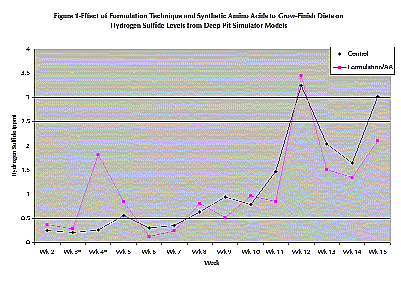
Figure 1 - Effects of formulation techniques and synthetic amino acids to grow-finish diets on hydrogen sulfide levels from deep pit simulator models.
Hydrogen sulfide levels were analyzed through a logarithmic transformation by the statistical software StatistixTM. Pigs fed the control diet had reduced (P <0.05) hydrogen sulfide emissions during weeks 2 and 3 of the trial. These differences were lost as the DPSM equilibrated and a numerical trend was observed for lower hydrogen sulfide emissions from manure pigs fed the SID diets during weeks 13, 14, and 15 Figure 1.
Note that low levels of hydrogen sulfide were emitted until approximately week 6 of the experiment. This suggests that approximately 6 weeks are required to generate enough biological activity to produce significant amounts of hydrogen sulfide in the DPSM. The variation in peaks and crossing of the data points indicate the variation which is expected in this biological model. It appears that pigs fed the SID diet produced manure, which was less capable of supporting microbes responsible for the production of hydrogen sulfide.
Ammonia emissions
Ammonia is a gas that is volatilized when the nitrogen in urine comes in contact with the enzyme urease, which is present in feces. Ammonia is of concern in pork production systems because it can affect the health of pigs and people at high concentrations. In general, the more acidic the slurry, the less ammonia will be volatilized.
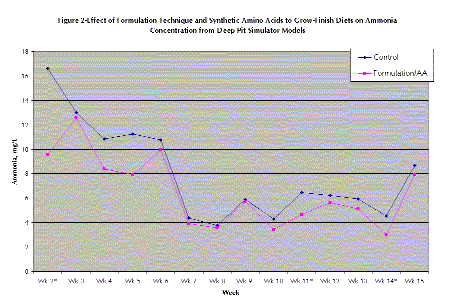
Figure 2 - Effects of formulation techniques and synthetic amino acids to grow-finish diets on ammonia concentration from deep pit simulator models.
Throughout the entire trial ammonia emissions were numerically lower for pigs consuming the SID diet. Ammonia emissions were lower (P < 0.05) from manure of pigs fed the experimental diet for weeks 2, 11, and 14 Figure 2. Ammonia and hydrogen sulfide gases are released under inverse environment conditions. When high levels of hydrogen sulfide are present, ammonia volatilization is reduced. As shown in Figure 2, ammonia levels appeared to be greater in the first 6 weeks of the trial, when hydrogen sulfide levels were relatively low.
Odor emissions
Odor detection units (ODU) are a measure of the lowest detection threshold of odor detected by human panelists of an air sample. Odor detection threshold is determined by diluting air samples with clean air in a device known as an olfactometer. The olfactometer has three settings, two represent clean air with no sample, and one setting is the diluted air sample. The odor panelist supervisor operates the olfactometer and assures that the first level is diluted enough so it is undetectable. Successive increases in sample air concentrations are released until panelists can detect the odor, and the procedure is repeated. A low ODU indicates that high concentrations of the air sample is needed in order to detect an odor.
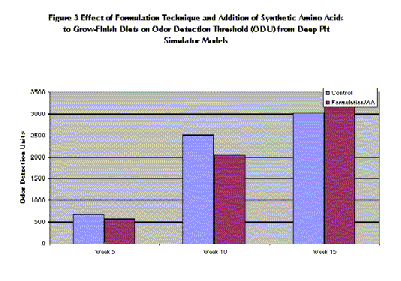
Figure 3 - Effects of formulation techniques and additions of synthetic amino acids to grow-finish diets oodor detection threshold from deep pit simulator models.
There were no differences in ODU of air samples collected in DPSM containing manure from pigs fed the control or the experimental diets Figure 3. For weeks 5, and 10, manure from pigs fed the experimental diet had numerically lower odor detection levels as compared to manure from pigs fed the control diet. However in week 15, manure from pigs fed the control diet had numerically less detectable odor levels. Since there are over 200 odorous compounds in swine manure, it is not surprising that the experimental diet did not reduce odor detection level, despite a numerical trend for reducing ammonia and hydrogen sulfide emissions.
Odor Intensity
Odor intensity is a measure of how strong an odor is compared to an n-butanol standard. Panelists smell air samples through an intensometer at 8, 25 and 100 percent concentrated samples diluted with clean air. After smelling the samples, panelists assign each air sample with a number on a 1 to 5 scale based on the intensity of the smell compared to the intensity of the n-butanol standard. A low number represents a less intense odor. There were no differences in odor intensity of air samples from manure of pigs fed the control and experimental diets Figure 4. Manure from pigs fed the experimental diet had numerically lower odor intensity levels compared to control fed pigs for week 5. However, in week 10 and 15, both treatments had manure that had relatively the same odor intensity had less intense odors. This implies that SID formulation and supplemental amino acids were ineffective in reducing the intensity of odors emitted from swine manure.
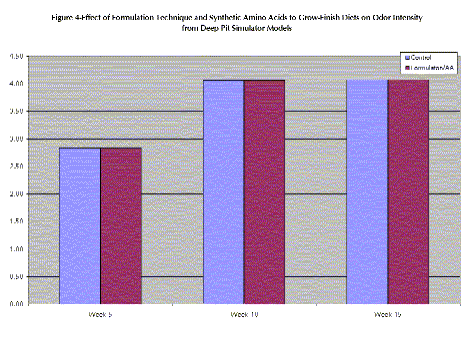
Figure 4 - Effects of formulation techniques and synthetic amino acids to grow-finish diets on odor intensity from deep pit simulator models.
Odor offensiveness
Hedonic tone measures the relative offensiveness of odors. Hedonic tone is important to measure because it portrays public perception to odors. Odor offensiveness is measured by human panelists, through an intensometer, who smell air samples diluted at 8, 25, and 100 percent concentration of the air sample. The panelist assigns a score based on the offensiveness of the odor on a numerical scale ranging from &mn;4 to +4. A high negative number indicates that the smell is very offensive and a high positive number indicates that the odor has a very pleasant smell.
There were no differences in odor offensiveness of air samples from manure of
pigs fed the control or the experimental diet. This implies that formulation
technique and supplemental amino acids had no effect on reducing the relative
offensiveness of swine manure odors. 
Figure 5 - Effects of formulation techniques and synthetic amino acids to grow-finish diets oon hedonic tone from deep pit simulator models.
Odor Persistence
Odor persistence is a measure of the relative distance an odor will carry from the source of the odor. It is calculated by plotting the intensity of the odor against its concentration. Persistence measures the amount of dilution an odor can withstand before it is undetectable. Two odors may have the same intensity but have very different persistence values. The higher the number, the further the odor can travel away from its source and be detected.
There were no differences in odor persistence of air samples from manure of pigs fed either of the two diets Figure 6. Manure from pigs fed the experimental diet had numerically lower persistence levels at week 5, but at weeks 10 and 15 the control pigs had less persistent odors. This indicates that SID formulation and supplemental amino acids were ineffective in reducing the persistence of odors emitted from DPSM.
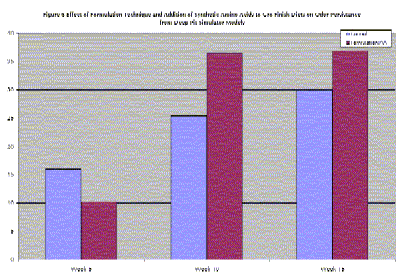
Figure 6 - Effects of formulation techniques and synthetic amino acids to grow-finish diets on odor persistance from deep pit simulator models.
Slurry pH and Temperature
Slurry pH and temperature may explain the degree of microbial fermentation in anaerobic manure storage units. With higher fermentation rates it is expected that slurry temperature will be increased. However, environmental conditions may affect and dictate temperature in the DPSM.
Slurry pH can be affected by many factors including concentrations of ammonium, volatile fatty acids, and carbonates present in swine waste (Cahn et al., 1998). Dietary inclusion of organic acids, oligosaccharides, inulin and other fermentable carbohydrate sources and formulating diets using dietary electrolyte balance (Na +K &mn;Cl) may reduce slurry and gastric pH (Cahn et al., 1998; Farnworth et al. 1995; Geisting et al., 1986). Anaerobic bacterial fermentation of carbohydrates produces lactic acid, which will reduce slurry pH. Additionally the degradation of proteins and amino acids will result in the production of amides and skatoles, which cause a decrease in pH (Hawe et al., 1992).
During weeks 4, 5, 6, 10, and 11, pigs fed the SID diet had lower (P < 0.05) slurry pH readings versus pigs fed the control diet Figure 7. The difference may be due to lower crude protein levels in the SID diet, which caused pigs to excrete less intact proteins or peptides in the feces, resulting in the production of more acidic manure. Concomitantly, there is a higher proportion of carbohydrate to protein concentration in the feces of pigs fed the SID diet, which results in the production of lactic, acetic, propionic and butyric acids (Mays, 1996). The lower pH of the slurry of pigs fed the SID diet may partly explain the reduction in ammonia emissions from manure of pigs fed the experimental diet.
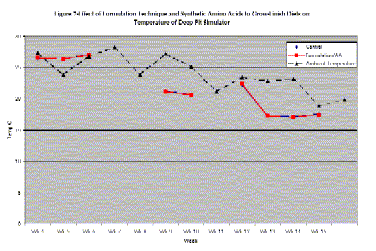
Figure 8 - Effects of formulation techniques and synthetic amino acids to grow-finish diets on temperature of deep pit simulator models.
The temperature of the DPSM is more regulated by environmental conditions than heat of fermentation. Figure 8 shows the temperature of the slurry of the control, and SID diet fed pigs and the ambient temperature. As volume in the DPSM increase, generally there is a decrease in DPSM temperature. There were no differences in slurry temperature between dietary treatments.
Summary
The use of SID formulation and adding synthetic amino acids had no effect on energy and nitrogen digestibility and excretion. However, feeding the SID diet reduced slurry pH, ammonia emissions and tended to reduce hydrogen sulfide emissions during weeks 13-15 of the study. Although it appears that some benefit was obtained for reducing gas emissions, feeding the SID diet had no effects on manure odor detection, intensity or hedonic tone.
Results from the soil lab for sulfur and slurry mineral values were not available at the time this report was written. When these results are available we will update this report.
Literature Cited